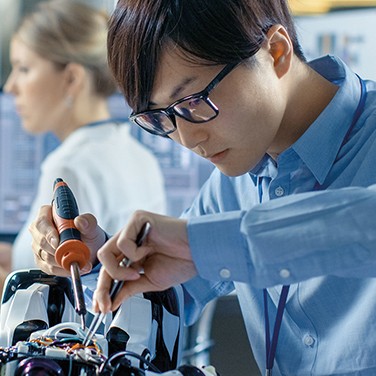Engineered Bacteria Help Robot Detect Chemicals
by Iva Fedorka
Soft robotics is expanding our definition of a robot. Engineers at the University of California, Davis, and Carnegie Mellon University recently created a gripping arm that responds to the reaction of transformed bacteria when a specific chemical is detected or “tasted.” This work was recently published in the journal Science Robotics. The gripper is their proof-of-concept for future biologically-based soft robotics.
Biomechanical Robots
Soft robotics refers to the use of lightweight and flexible or “soft” materials to replicate the activities of living things. In the path toward creating actual biological-mechanical hybrids, adding living cells to soft robots may be the next step.
“By combining our work in flexible electronics and robotic skin with synthetic biology, we are closer to future breakthroughs like soft biohybrid robots that can adapt their abilities to sense, feel, and move in response to changes in their environmental conditions,” said Carmel Majidi, a co-author and associate professor of mechanical engineering at CMU.
Integrating synthetic biology and robotics may provide the opportunity to add sensory, diagnostic, and therapeutic functionality to bioinspired machines. To date, adequate soft-matter architecture has been lacking, as are cell-to-electronics interfaces, and actuators for stimulation and response.
An Innovative Design
The new device uses competent Escherichia coli bacteria that have been engineered to produce a fluorescent protein in response to the chemical IPTG. IPTG (isopropyl-β-D-thiogalactoside) is a galactose analog, commonly used in molecular biology procedures. The transformed E. coli cells are enclosed in wells with flexible, porous membranes on the bottom. The membranes let chemicals enter the wells while containing the bacteria.
A hydrogel infused with the IPTG is alternately pressed and released by a hybrid bio-LED-actuator incorporated into the surface of a flexible finger-like gripper on a robotic arm. When the IPTG in the gel crosses the membrane into the chamber, the bacteria fluoresce in response.
A flexible LED circuit inside the module detects the light and converts it to an electronic signal. The signal travels to the gripper control unit, which acts to pick up and release an object. The test process used the gripper to check a laboratory water bath for IPTG and then decide whether to use its soft pneumatic actuators to place an object in the bath.
"We are closer to future breakthroughs"
A New Path
This work opens previously unidentified avenues in soft materials, synthetic biology, and integrated interfacial robotic systems.
“Our long-term vision is about building a synthetic microbiota for soft robots that can help with repair, energy generation, or biosensing of the environment,” said Cheemeng Tan, assistant professor of biomedical engineering at UC Davis.
This particular biohybrid robot can only detect one substance, and it may be difficult to build a system that detects changing concentrations, Tan said. It is also a challenge to maintain a stable population of microbes that compares to the human body’s microbiome or ecosystem of bacteria and fungi that live in or on our own bodies and carry out many useful functions for us.
However, Tan believes that biohybrid systems potentially offer more flexibility than conventional robotics. Bacteria could be engineered for different robotic functions, like detecting other chemicals, making polymers for repairs, or generating energy.
The work was supported by the National Science Foundation, the Air Force Office of Scientific Research, and the Office of Naval Research.



